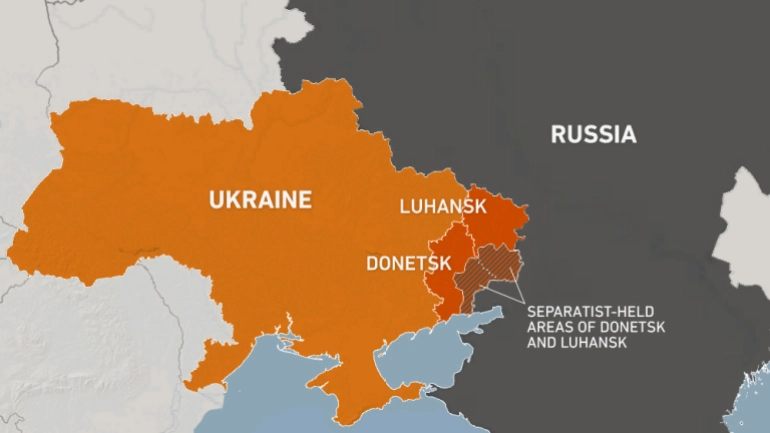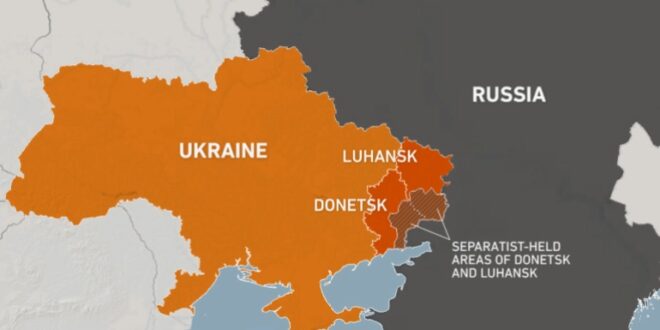Why are Ukraine’s NATO ambitions so controversial? And could an all-out war break out? We answer the critical questions.
NATO allies, fearful of a potential ground invasion by Russia, have stepped up support for Kyiv by sending additional troops and military equipment to Ukraine.
The alliance says its move is in response to Russia’s continued military buildup along the Ukraine border.
Moscow claims its actions are necessary to secure vital security interests and blames NATO for undermining the region’s security.
Here are five things you should know about what’s happening now and what could come next.
Why is there a conflict?
Ukraine, which was part of the Russian empire for centuries before becoming a Soviet republic, won independence as the USSR broke up in 1991. It moved to shed its Russian imperial legacy and forge increasingly close ties with the West.
A decision by Kremlin-leaning Ukrainian President Viktor Yanukovych to reject an association agreement with the European Union in favour of closer ties with Moscow led to mass protests that saw him removed as leader in 2014.
Russia responded by annexing Ukraine’s Crimean Peninsula and throwing its weight behind a separatist rebellion that broke out in Ukraine’s east.
Ukraine and the West accused Russia of sending its troops and weapons to back the rebels. Moscow denied that, saying the Russians who joined the separatists were volunteers.
According to Kyiv, more than 14,000 people have died in the fighting that devastated Donbas, Ukraine’s eastern industrial heartland.

For its part, Moscow has strongly criticised the US and its NATO allies for providing Ukraine with weapons and holding joint drills, saying that such moves encourage Ukrainian hawks to try to regain the rebel-held areas by force.
Furthermore, Russian President Vladimir Putin has repeatedly said Ukraine’s aspirations to join NATO are a red line, and expressed concern about plans by some NATO members to set up military training centres in Ukraine. This, he has said, would give them a military foothold in the region even without Ukraine joining NATO.
What does Russia want?
It is more about what Russia doesn’t want. Russia does not want Ukraine in NATO – and has said as much in its list of security demands which were sent to the US last December. The demands included a halt to any NATO drills near Russia’s border.
Many of these ultimatums have been slammed as non-starters by the West. It also wants NATO to withdraw from Eastern Europe.
In December, Putin said Russia was seeking guarantees “that would exclude any further NATO moves eastward and the deployment of weapons systems that threaten us in close vicinity to Russian territory”.
Putin offered the West an opportunity to engage in substantive talks on the issue, adding that Moscow would need not just verbal assurances, but “legal guarantees”.
Ukraine’s admission to the alliance would require the unanimous approval of the 30 states that make up the body.
The US and NATO have now responded to the calls. While neither Moscow nor the Western powers have gone public with the details of those responses, it has been made clear that Russia’s main demands – Ukraine essentially banned from being a NATO member and a promise that the alliance won’t expand further east – have been turned down.
Will Ukraine join NATO?
Ukraine is not a NATO member, but it wants to be. It is considered a partner of the alliance.
Before being considered for membership, NATO says, Kyiv needs to root out scourges such as corruption.
NATO Secretary-General Jens Stoltenberg in December rejected Russian demands to rescind a 2008 commitment to Ukraine that the country would one day become a member.
Stoltenberg maintains that when the time comes to consider the issue, Russia will not be able to veto Ukraine’s accession.
Analysts however say that NATO allies, the United States chief among them, are reluctant to expand their military footprint in the region and further jeopardise their relationship with Moscow.
While US Secretary of State Antony Blinken has voiced support for Ukraine’s membership in NATO, President Joe Biden has been more ambiguous on the question.
Will there be all-out war?
The West is accusing Russia, which has massed 100,000 troops on the Ukrainian border, of preparing to invade its pro-Western neighbour.
Biden claims “total unanimity” on how to deal with Russia. The Pentagon has put 8,500 US troops on standby for an Eastern European deployment and NATO said it was sending ships and jets to bolster the region’s defences.
President Putin’s spokesman Dmitry Peskov said these actions only added to an already tense atmosphere.
“The United States is escalating tensions,” he told reporters. “We are watching these US actions with great concern.”
Russia denies it has any plans to invade Ukraine and accuses the West of aggravating the situation.
It is uncertain whether war will break out between the two countries but some analysts say Russia could move in on Ukraine to claim a quick, decisive victory and increase its bargaining power in future talks about NATO’s expansion and spheres of influence.
“I think what Russia and Vladimir Putin will be really after would be to defeat the Ukrainian armed forces in the field, inflict a crushing military defeat that humiliates the Ukrainians and by extension create concern that the backing Ukraine has from its allies in the West, the US and UK, is insufficient,” said Samir Puri, a senior fellow at the International Institute for Strategic Studies.
What happens if Russia invades Ukraine?
Western nations have thrown their support behind Ukraine, but some responses have been tougher than others. The US and UK have supplied weapons, while Germany plans to send a field medical facility next month but will not transfer military equipment.
There has also been much talk of sanctions aimed at punishing Moscow. Publicly, the US and European allies have promised to hit Russia financially like never before if Putin does roll his military into Ukraine. Leaders have given few details, arguing it is best to keep Putin guessing, but Washington and London have spoken of personal measures targeting the Russian president.
Cutting Russia out of the SWIFT financial system, which moves money from bank to bank around the globe, would be one of the toughest financial steps they could take, damaging Russia’s economy immediately and in the long term.
The move could cut Russia off from most international financial transactions, including international profits from oil and gas production, which accounts for more than 40 percent of the country’s revenue.
The US also holds one of the most powerful financial weapons against Putin if he invades Ukraine – blocking Russia from access to the US dollar.
Dollars still dominate in financial transactions around the world, with trillions of dollars in play daily.
Finally, the US is considering imposing export controls, potentially cutting Russia off from the high tech that, among other things, helps warplanes and passenger jets fly and powers smartphones.
 Eurasia Press & News
Eurasia Press & News



